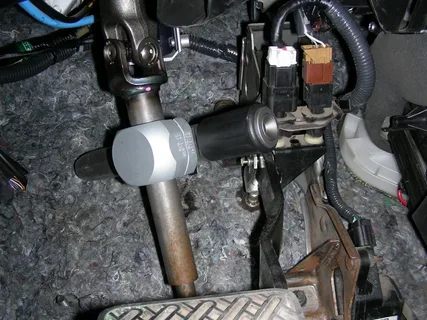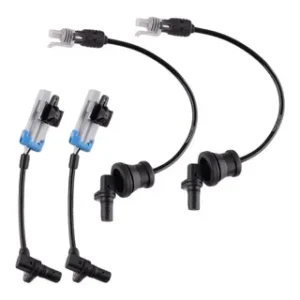The Nissan X-Trail Power Steering Hose plays a pivotal role in the vehicle’s steering system by enabling the transfer of hydraulic fluid from the pump to the steering gear. This process allows for smooth and effortless maneuverability, ensuring the driver can easily control the vehicle. Steering becomes significantly more difficult without a properly functioning power steering hose, leading to potential safety risks. The hose must be maintained in good condition to prevent hydraulic fluid leaks and ensure the steering system operates efficiently.
Indicators of Deterioration
Over time, the power steering hose of the Nissan X-Trail can exhibit signs of wear and degradation. Leaks are a prominent indicator, often as fluid puddles beneath the vehicle. Another key sign is an unusual increase in the effort required to turn the steering wheel, which unusual noises may accompany. A visual inspection might reveal cracks, bulges, or abrasions along the hose’s length.
These symptoms suggest that the hose may no longer be maintaining proper hydraulic pressure, thereby impairing the efficiency of the steering system. Recognizing these indicators early can be instrumental in preventing more severe issues and ensuring the vehicle remains safe to drive.
Routine Examination
Conducting routine examinations of the power steering hose is crucial for maintaining optimal vehicle performance. Regular visual checks are recommended, ideally with other scheduled vehicle maintenance tasks. Key areas to inspect include the connections where the hose attaches to the pump and steering gear, as these are common sites for wear and tear. Look for any signs of cracks, bulges, or abrasions along the length of the hose.
Additionally, ensure there are no leaks or loose fittings. If any damage is observed, it should be addressed promptly to prevent further complications. Regular inspections help identify potential issues before they escalate, ensuring the longevity and reliability of the steering system.
Tips for Cleaning and Upkeep
Regular cleaning and upkeep of the power steering hose are vital for ensuring the long-term performance and reliability of your vehicle’s steering system. Keeping the hose clean prevents the accumulation of dirt, grime, and debris, which can lead to potential wear or even system failure.
Use a Mild Detergent
When cleaning the power steering hose, use a mild detergent or a specialized automotive cleaner. These cleaning agents effectively remove contaminants without damaging the hose material. Avoid strong chemicals, which may deteriorate the hose or its protective coatings.
Use a Soft Cloth
A soft cloth should be used to clean the hose to avoid scratching or damaging its surface. Harsh scrubbing tools or abrasive materials can wear down the hose over time, leading to potential leaks or premature failure. Gently wiping the surface ensures the hose remains intact and functional.
Detecting Wear and Tear
Routine cleaning helps you spot early signs of wear and tear on the hose. If the hose is obscured by dirt or grime, it may be harder to identify cracks, leaks, or frayed edges that could lead to a malfunction. Regular cleaning facilitates early intervention, preventing more serious issues.
Inspect Hose Connections
It’s also important to check the hose connections and fittings regularly. Built-up grime around these areas can mask leaks or damage that would otherwise be noticeable. Keeping these parts clean ensures that all connections remain tight and contamination-free.
Enhancing System Longevity
By maintaining cleanliness, you ensure that the hose remains in optimal condition and contribute to the overall longevity and reliability of the power steering system. A well-maintained hose helps maintain consistent steering performance, reducing the likelihood of unexpected repairs.
Timing for Hose Replacement
Persistent leaks or visible damage to the power steering hose necessitate immediate replacement to ensure vehicle safety and optimal performance. Ignoring these issues can lead to complications such as steering failure or further damage to related components. It is advisable to inspect the hose periodically and replace it if any significant wear or deterioration is detected.
Additionally, if the steering becomes increasingly tricky or unusual noises are heard, these could indicate that a replacement is required. Replacing the hose at the right time can prevent costly repairs and ensure the longevity of the steering system. Regular monitoring and timely intervention are crucial to maintaining the vehicle’s efficiency and safety.
Advantages of Proper Hose Upkeep
Proper maintenance of the power steering hose in a Nissan X-Trail yields several benefits, including enhanced steering precision and reduced risk of steering failure. Hydraulic fluid flows smoothly by keeping the hose in optimal condition, ensuring consistent and responsive steering. Regular upkeep can also minimize the likelihood of leaks and the resultant fluid loss, which can otherwise lead to increased wear on the steering pump.
Investing in the hose’s upkeep can prevent unexpected breakdowns, contributing to safer driving conditions. High-quality maintenance practices extend the lifespan of the steering system components, reducing the frequency of costly replacements and repairs. Overall, attentive hose upkeep supports the vehicle’s performance and reliability.
Selecting the Appropriate Replacement Hose
Selecting the proper replacement Nissan X-Trail Power Steering Hose involves carefully considering various factors. Matching the new hose to the original equipment manufacturer’s specifications is essential to ensure compatibility and maintain the vehicle’s performance.
Choosing hoses made from high-quality materials is critical to withstand hydraulic pressure and temperature fluctuations. opt for products from reputable brands known for their reliability and durability. Additionally, it is advisable to purchase from trusted suppliers to avoid counterfeit parts, which can lead to frequent replacements and compromised safety.
Checking for warranties or guarantees can also provide additional assurance of the hose’s quality. Proper research and attention to detail when selecting a replacement hose will help ensure the continued efficiency and safety of the steering system.
Guide for Installing
Before starting the installation, ensure you have all the required tools: spanners, clips, a hydraulic fluid drain pan, and a jack with stands. Having everything on hand will make the process smoother and more efficient.
Elevate the Vehicle
Use a jack to lift and secure the vehicle with stands for safety. This will provide the necessary clearance to work underneath the car, allowing you to access the power steering components.
Drain Hydraulic Fluid
Before disconnecting any hoses, drain the hydraulic fluid from the power steering system. This prevents spills and minimizes the mess when removing the old hose. Be sure to catch the fluid in a drain pan for proper disposal.
Remove the Old Hose
Disconnect the old power steering hose from the pump and the steering gear. Keep a rag handy to manage any residual fluid. Take care not to damage any surrounding components during the removal process.
Install the New Hose
Attach the new power steering hose to the corresponding connections, following the vehicle’s manual for precise instructions. Ensure all fittings and clips are securely tightened to prevent leaks or loose connections.
Refill and Bleed the System
Refill the hydraulic fluid to the manufacturer’s recommended level and bleed the system to remove any air pockets. This step is crucial to ensure the system operates smoothly and efficiently.
Preventative Strategies
Routine maintenance checks, including regular inspections and timely cleaning, will help identify potential issues early. Ensuring the hydraulic fluid is at the recommended level and free from contaminants will also support the hose’s optimal function.
Monitoring the hose’s connections for any signs of loosening or wear is advisable. Regularly checking the vehicle’s manual for specific maintenance guidelines can be beneficial. Using high-quality hydraulic fluid and replacing it at recommended intervals can also play a crucial role in extending the life of the power steering hose.
In addition, ensuring the hose is protected from excessive heat and sharp objects can prevent premature wear. Employing these strategies can significantly reduce the risk of unexpected failures and enhance the longevity of the power steering hose.
Seeking Expert Help
If uncertainty arises about the condition of the power steering hose or the replacement process appears challenging, consulting a professional mechanic is recommended.
- Experts possess the necessary tools and expertise to diagnose and rectify issues accurately.
- They can conduct thorough inspections and provide reliable repairs, ensuring the hose is installed correctly and functions efficiently.
- Professional services also come with the added benefit of warranties, offering peace of mind.
- When engaging with a mechanic, it is advisable to verify their credentials and experience with Nissan X-Trail models to ensure high-quality service.
- Additionally, professional maintenance can help identify problems that might not be visible to the untrained eye, preventing further complications.
Common Errors to Avoid
Using the wrong type of hydraulic fluid can cause significant damage to the power steering hose and the entire steering system. Ensuring that the correct fluid type, as specified in the vehicle’s manual, is used is essential.
Another common mistake is to pay attention to bleed the system properly after installing a new hose. This can lead to air pockets within the hydraulic system, causing reduced steering efficiency and potential damage. Failing to secure fittings and clips tightly can also result in leaks and reduced performance.
Substandard or counterfeit hoses can also lead to frequent replacements and pose safety risks. It is vital to invest in high-quality, compatible parts. Lastly, overlooking the importance of periodic inspections can cause minor issues to escalate into significant problems, leading to costly repairs and compromised safety.
Encouragement for Consistent Maintenance
Consistent Nissan X-Trail power steering hose maintenance is fundamental for vehicle longevity and performance. Regular inspections and timely replacements help identify and address potential issues before they escalate, ensuring the steering system remains reliable and efficient.
By adhering to the manufacturer’s maintenance guidelines, drivers can mitigate the risk of leaks, steering difficulties, and unexpected breakdowns. Investing in high-quality components and using the correct hydraulic fluid is crucial to preserving the hose’s integrity.
Through diligent upkeep, drivers can enhance their vehicle’s safety and enjoy a smoother driving experience. Prioritizing the condition of the power steering hose is a proactive approach to maintaining the Nissan X-Trail’s optimal performance.
Conclusion
The Nissan X-Trail Power Steering Hose is a crucial component that ensures smooth and effortless steering. You can maintain optimal steering performance and prevent potential issues by understanding its function, recognizing signs of wear, and performing regular maintenance. If you notice any signs of damage, leaks, or stiffness in the steering, it is recommended to consult a qualified mechanic for diagnosis and repair.
FAQs
What are the common signs of a failing power steering hose in a Nissan X-Trail?
Some common signs of a failing power steering hose include:
· Visible cracks or bulges in the hose
· Fluid leaks from the hose
· Stiff steering, especially at low speeds
· Squealing or whining noises from the power steering system
How often should I inspect the Nissan X-Trail Power Steering Hose?
It is recommended that you inspect the Nissan X-Trail Power Steering Hose at least once a year or more frequently if you drive in harsh conditions or off-road. A visual inspection can help identify any signs of wear, damage, or leaks.
Can I replace the power steering hose on my Nissan X-Trail myself?
Replacing the power steering hose on a Nissan X-Trail can be a complex task that requires specialized tools and knowledge. A qualified mechanic should perform this work to ensure proper installation and avoid potential damage to the vehicle’s steering system.
| Related Business Listings |
| Contact Directory |
| Local Business Profiles |



